There are many different types of spiders with red and black markings. The most infamous is the black widow, with its shiny black body and notable red hourglass marking. The red colorations on many spiders can appear almost orange. Therefore, orange-and-black and red-and-black spiders are typically in the same category.
Not all red and black spiders are dangerous. Many are completely harmless, and most of the time, even beneficial. Let’s look at some of the most common red and black spiders in the United States and Canada.
1. Red Widow

Red widow spiders have entirely red-brown bodies, with the exception of their black abdomen.
©Florida Division of Plant Industry Archive / CC BY 3.0 US, via Wikimedia Commons – License
The adult red widow specializes in capturing flying insects. Only the females are red and black, while the males are much less eye-catching. Like their better-known cousins, they feature red dots on a black abdomen, though the hourglass shape is not as defined. They have a light brown body and long, pointed orange legs. It measures up to 13 mm long, though it can measure up to 5 cm when the legs are included.
Usually, the females build their webs around 3′ to 10′ above the ground. However, younger spiders may have their webs closer to the ground. Their web is a basic cobweb shape with lots of snare lines. These lines catch flying insects, which comprise the bulk of the spider’s diet.
These spiders live in Florida and spend much of their time in sand dunes. They are venomous but aren’t dangerous to humans. In fact, there is no record of their bite ever causing a reaction in humans.
2. Southern Black Widow

Females, which tend to be larger than males, are venomous and have the identifiable red hourglass on their abdomen.
©Jeff W. Jarrett/Shutterstock.com
The southern black widow spider is well-known throughout much of the United States. It’s one of the more venomous spiders, though its venom is rarely deadly in people. It has a rounded, shiny black abdomen and pretty long legs. They can grow up to 13 mm, excluding the legs.
They’re often called simply “black widows.” Females, which tend to be larger than males, are venomous and have the identifiable red hourglass on their abdomen. If you ever see one, care should be taken, as their bites can cause severe pain.
3. Northern Black Widow
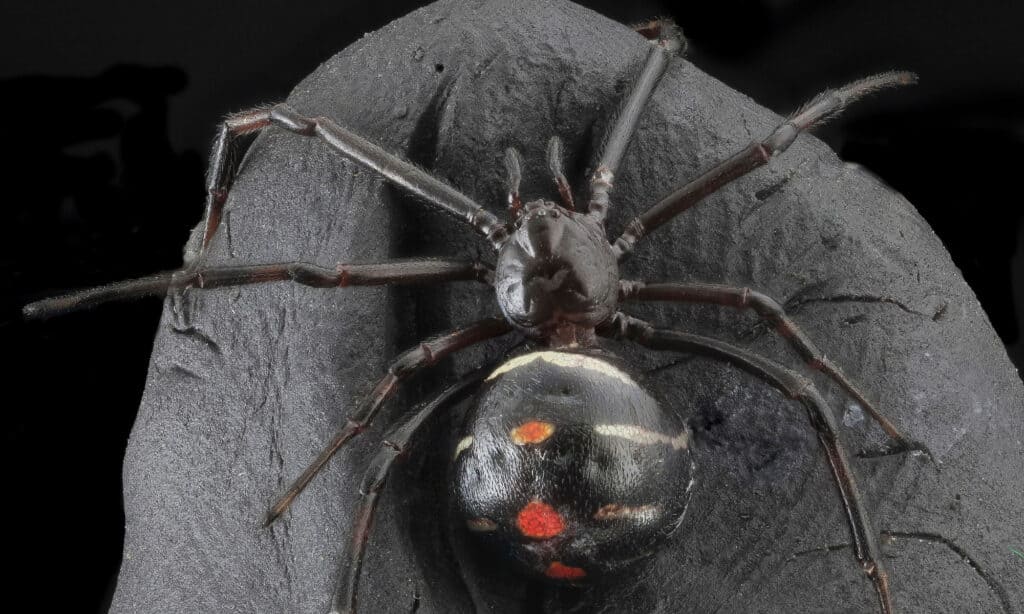
Unlike other black widows, northern black widows have a broken hourglass-shaped marking on their abdomen.
©Porco_Rosso/Shutterstock.com
The northern black widow spider looks different than its southern counterpart, with its identifiable feature being three or more red dots. These bright markings are sometimes referred to as forming a “broken hourglass.” They’re venomous, just like other black widows. They can grow up to 13 mm long; however, their legs can be twice as long as their body.
4. Mediterranean Black Widow
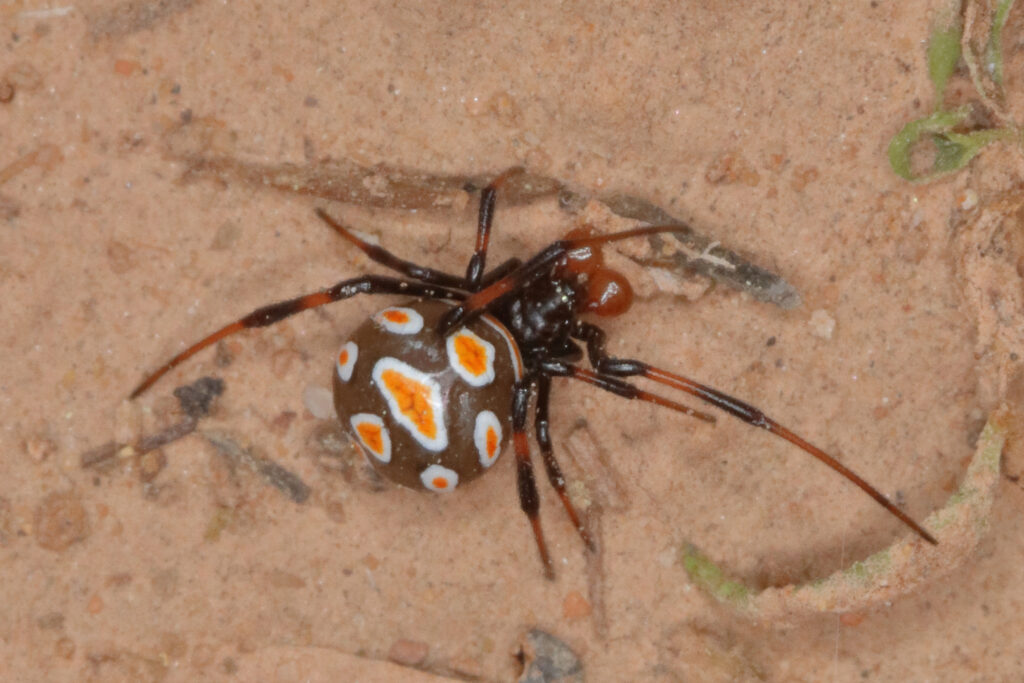
The easiest way to identify the Mediterranean black widow is by their multitude of colorful dots.
©iStock.com/Frank Buchter
The Mediterranean black widow spider is easily recognized by the thirteen red, orange, or yellow dots spread across its abdomen. They’re rather large at up to 15 mm. They also have long legs relative to their body, like the rest of their family members.
Their legs appear dark brown or orange. However, the easiest way to identify them is by their multitude of colorful dots.
5. Brown Black Widow
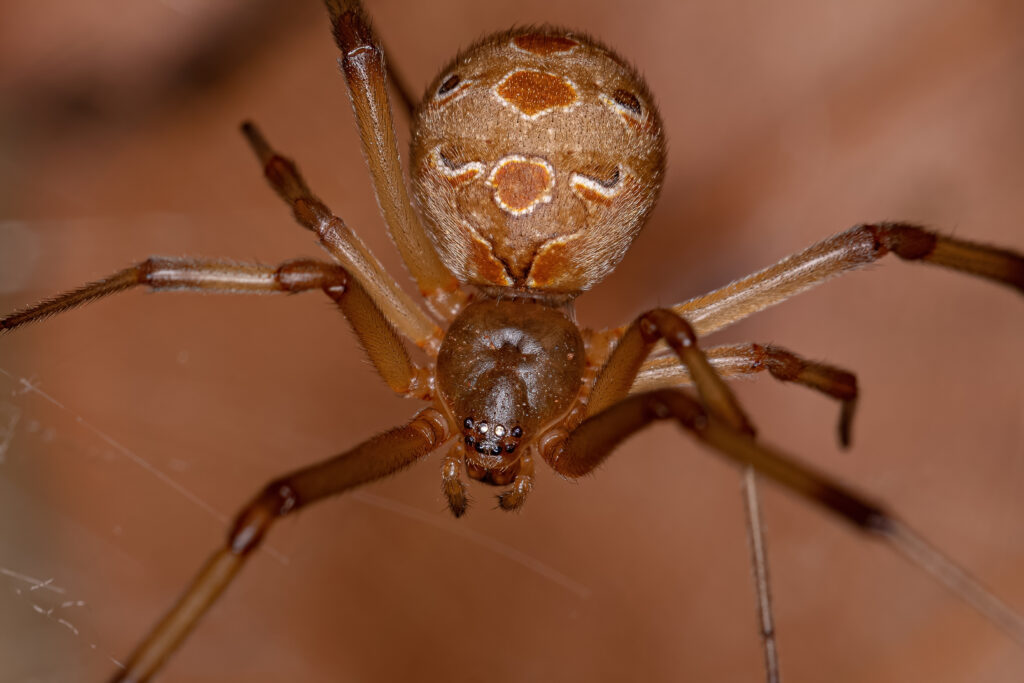
Brown black widows have a light brown to dark brown body and a broken hourglass on their underside.
©iStock.com/ViniSouza128
As their name suggests, this spider is both brown and black. They have a light brown to dark brown body and a broken hourglass on their underside. This spider is sometimes mistaken for the southern black widow. However, close observers will see that this species is brown, and lacks the bright red marking of their famous relatives.
Their bite isn’t dangerous. Though still technically venomous, it is often described as feeling closer to a bee sting.
6. Emerton’s Bitubercled Cobweaver
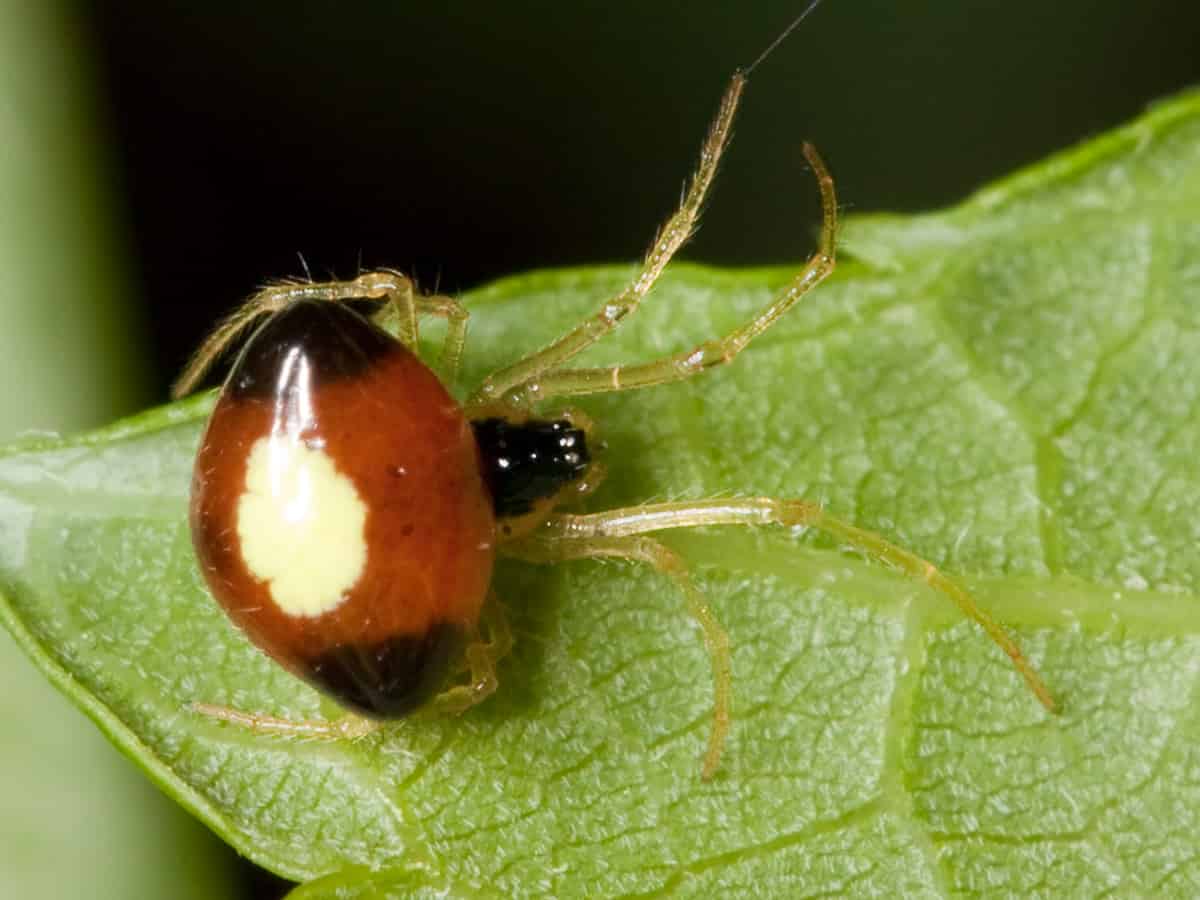
Because they have an abdomen several times larger than their head, they look more like bugs than spiders!
©Kaldari_Public Domain – License
The cobweaver is one of the smallest and interesting-looking spiders on this list. Males only grow up to 1.5 mm, while females can get as big as 2.3 mm. Because they have an abdomen several times larger than their head, they look more like bugs than spiders.
They’re mostly a reddish-brown color. However, the legs are pale yellow, and the head tends to be darker. They have some black markings, too. However, these are hard to see without a magnifying glass because the spiders are so small.
7. Red-Backed Jumping Spider
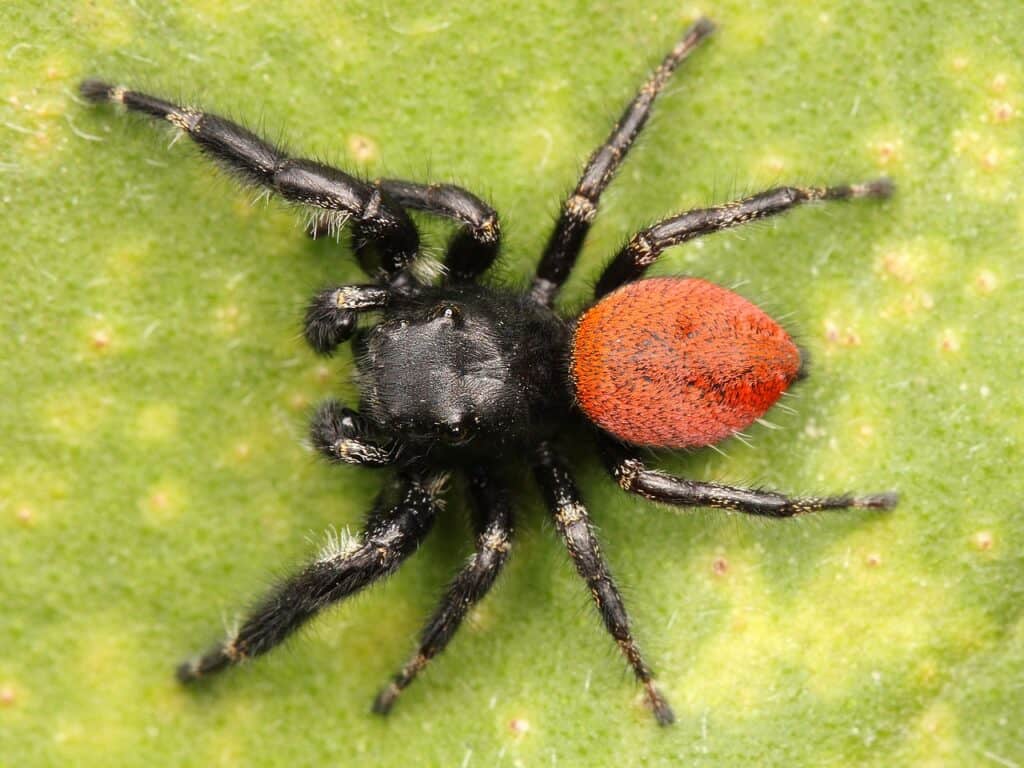
This jumping spider is striking indeed! It has a black cephalothorax and a bright red abdomen.
©Kaldari / CC0 via Wikimedia Commons – License
The red-backed jumping spider is striking indeed! It has a black cephalothorax and a bright red abdomen, with females displaying a black stripe down their middle. Tiny white and black hairs cover their legs. This species is one of the larger jumping spiders. They measure around 9 to 14 mm long, with males being smaller than females.
Although their seemingly erratic jumping can be startling, they are completely harmless. Many people even keep them as pets due to their flashy coloration. Their bright colors also make them easy to identify.
8. Apache Jumping Spider
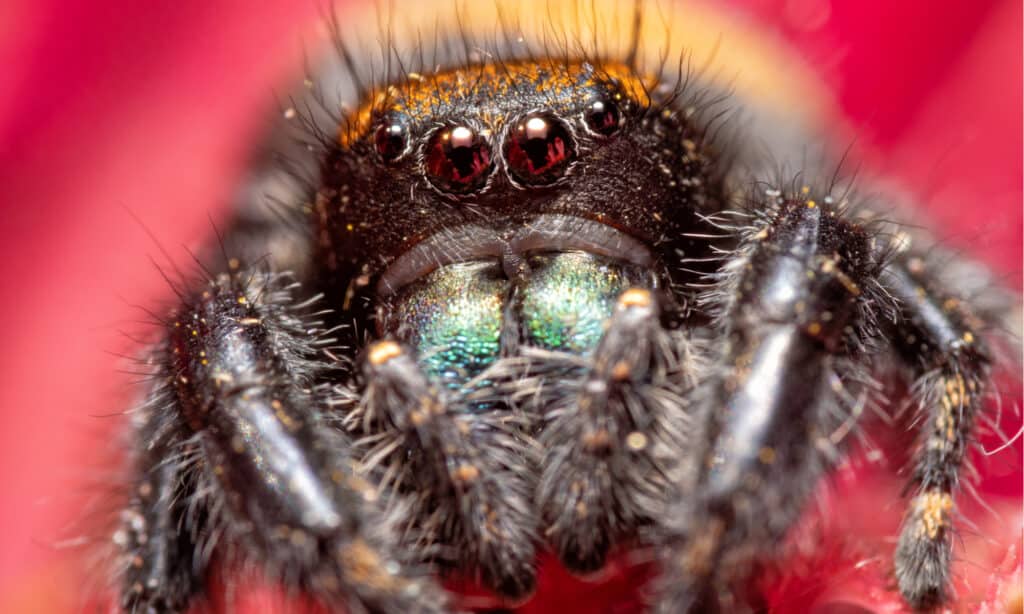
Their body is fuzzy and almost entirely red or orange.
©Sari ONeal/Shutterstock.com
The Apache spider is similar to the red-backed jumping spider. However, their body is fuzzy and almost entirely red or orange, though the female has a black stripe on its abdomen. The female can reach up to 22 mm, making this species much larger than other jumping spiders.
9. Cardinal Jumper
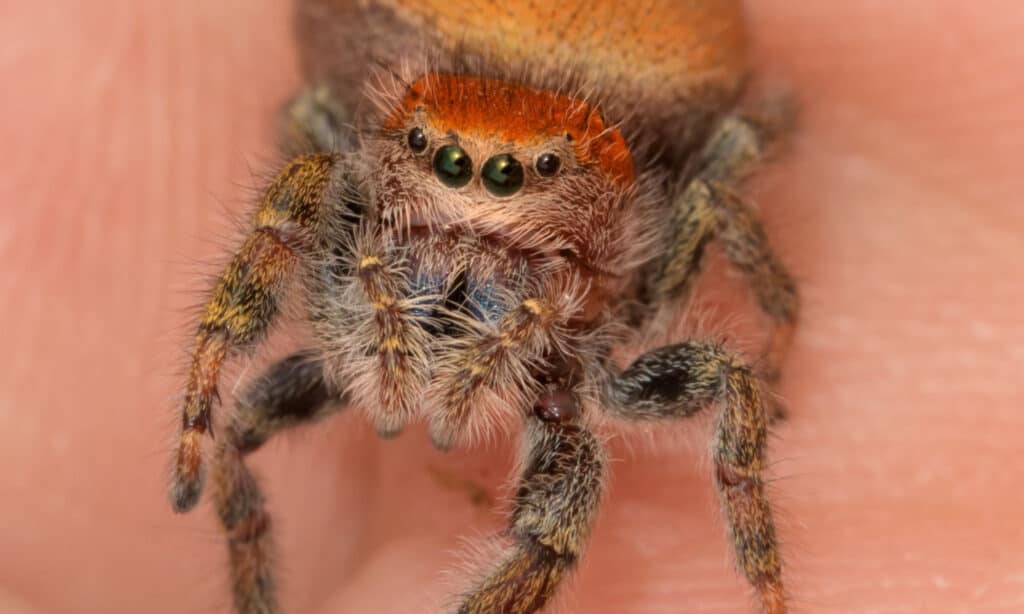
These tiny spiders are very colorful and furry, with two prominent eyes.
©Sari ONeal/Shutterstock.com
This tiny jumping spider is red with black legs. They’re very colorful and furry, with two prominent eyes. They’re much smaller than other spiders, measuring around just 10 mm long.
These spiders are sometimes mistaken for mutillid wasps. However, they do not sting and are completely harmless to people.
10. Whitman’s Jumping Spider
Whitman’s jumping spider has a red furry body, though its legs and underside are black. They have tiny white spines covering their legs, giving them a grey appearance. They only measure up to 10 mm long.
11. Bold Jumping Spider

This jumping spider’s legs are much shorter than those of a black widow.
©Sari ONeal/Shutterstock.com
The bold jumping spider has three prominent orange and red spots on its black abdomen. They have short legs, though their front legs are particularly wide. They can measure up to 11 mm long, making them relatively small.
They’re sometimes confused for black widows due to their orange spots. However, their spots tend to form a triangle instead an hourglass. Additionally, as a jumping spider, their legs are much shorter than those of a black widow.
12. Spiny-Backed Orb Weaver

Crab spiders have a very obvious, broad, white abdomen with red spines and black dots.
©iStock.com/Weber
The spiny-backed orb weaver is known for its unusual appearance. All orb weavers tend to look strange when compared to the stereotypical spider; however, this species wins the weirdest spider award!
They have a very obvious, broad, white abdomen with red spines and black dots. Their legs are black with red bands towards the bottom.
They look a bit like crabs and are often called “crab spiders” for this reason. They measure about 9 mm wide and 13 mm long.
13. Red-Headed Mouse Spider

The red-headed mouse spider has a neon red head and jaws. Their abdomen is a distinct iridescent blue, while their legs are solid black.
©Wright Out There/Shutterstock.com
Appropriately named, the red-headed mouse spider has a neon red head and jaws. Their abdomen is a distinct iridescent blue, while their legs are solid black. Additionally, they are almost hairless.
Their large, brightly colored jaws can look a bit scary, but these spiders are harmless to people. Interestingly, only males have this red coloration. The female is brown and looks completely different.
14. Dwarf Spider
The dwarf spider has a black abdomen, but the rest of its body is brown. Their abdomen is extremely large and ball-like, which can give them a bit of a comical appearance. Their four black eyes stand out against their orange head.
These tiny spiders only measure 3 mm. Therefore, you often need a magnifying glass to see its features.
15. Blacktailed Red Sheetweaver

They have a black “tail” that sets them apart from other spiders.
©Robert Webster / xpda.com / CC-BY-SA-4.0 – License
This species of dwarf spider has tiny black legs and a reddish-brown body. They have a black “tail” that sets them apart from other spiders. They’re extremely small at only 4 mm. You’ll need a magnifying glass to really identify them.
The blacktailed red sheetweaver is most commonly found in the grasslands of Florida and the southeastern United States.
16. Red-Legged Purseweb Spider
These shiny spiders are large at up to 25 mm long. They create a tunnel-like web that traps their insect prey. Spotting one is unlikely because they rarely venture out of these webbed enclosures.
They have orange-red legs translucent legs, but the rest of their body is black. Due to their larger size, identifying them is often pretty straightforward.
Summary Of The 16 Black And Red Spiders
| 1 | Red Widow |
| 2 | Southern Black Widow |
| 3 | Northern Black Widow |
| 4 | Mediterranean Black Widow |
| 5 | Brown Black Widow |
| 6 | Emerton’s Bitubercled Cobweaver |
| 7 | Red-Backed Jumping Spider |
| 8 | Apache Jumping Spider |
| 9 | Cardinal Jumper |
| 10 | Whitman’s Jumping Spider |
| 11 | Bold Jumping Spider |
| 12 | Spiny-Backed Orb Weaver |
| 13 | Red-Headed Mouse Spider |
| 14 | Dwarf Spider |
| 15 | Blacktailed Red Sheetweaver |
| 16 | Red-Legged Purseweb Spider |
Bonus: What Keeps Spiders Away?

Essential oil scents like peppermint are repugnant to spiders.
©Madeleine Steinbach/Shutterstock.com
One of a person’s worst nightmares is having spiders wind up in their home–especially the venomous kind! The best way to avoid getting bitten by a spider is to try and prevent them from entering your house in the first place. As spiders can get into your home through holes and cracks, you can check for possible entryways with a flashlight. If the light gets through from the inside to the outside, you should fill that hole or crevice with an appropriate product.
Keeping your yard free of debris and overgrown vegetation helps cut down on areas spiders would gravitate to. Caulking doors and windows is also a good strategy to keep them out.
Spiders hate certain scents, so scented essential oils can help deter them like peppermint, tea-tree, lavender, and rose. You can add 15-20 drops of a particular oil in a water bottle mixed with water and spritz it around your house. They also hate the smell of cinnamon and vinegar, so these scents can be used similarly.
Regular cleaning inside your home, especially in areas that are dark or less frequented, is necessary to keep spiders from setting up residence. It’s also important to keep an eye on fruit bowls, as they can attract spiders.
The photo featured at the top of this post is © iStock.com/maria72
Thank you for reading! Have some feedback for us? Contact the AZ Animals editorial team.






